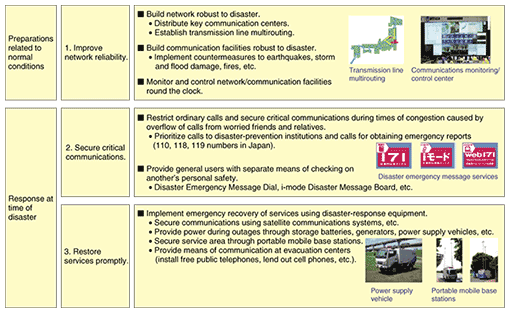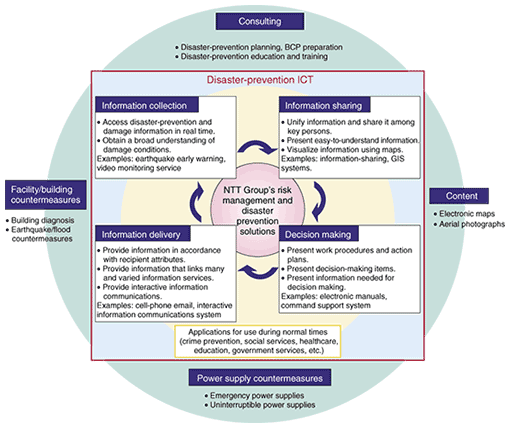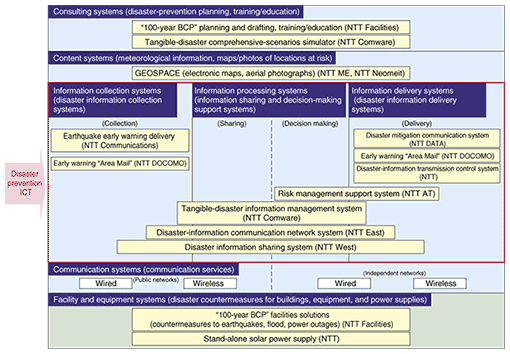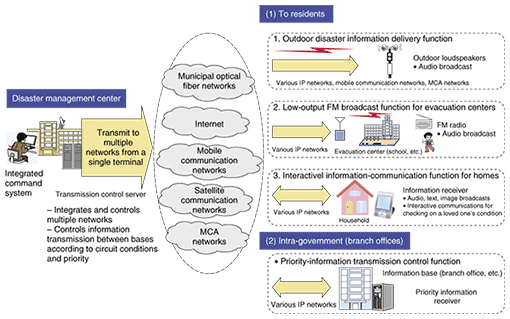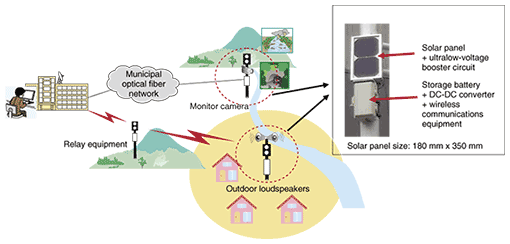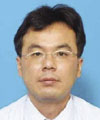 |
|||||||||||||||||
|
|
|||||||||||||||||
|
Special Feature: Risk Management and Disaster Prevention Solutions by NTT Group Vol. 6, No. 12, pp. 4–11, Dec. 2008. https://doi.org/10.53829/ntr200812sf1 NTT Group's Risk Management and Disaster Prevention Solutions and R&D InitiativesAbstractThis article introduces the NTT Group's risk management and disaster prevention solutions and R&D initiatives for meeting the needs of national and local governments as well as companies, which are taking steps to use information and communications technology to collect, transmit, and share disaster information rapidly and reliably so as to minimize damage and restore services promptly.
1. Market trends in risk management and disaster preventionVarious regions in Japan have recently suffered devastating natural disasters ranging from earthquakes to flooding caused by typhoons and torrential rain. These disasters are reported to have caused major damage. Thus, in the face of increasingly diversified risk that has come to include widespread system failures, pandemics, and terrorism, national and local governments and also companies are adopting a variety of risk management and disaster-prevention measures. In carrying out these measures, they are finding that prompt decisions and actions based on the reliable transmission, sharing, and use of information are essential in order to minimize damage and achieve prompt recovery. To carry out emergency measures and support recovery appropriate to disaster conditions, the national government is promoting cross-organization sharing of disaster-prevention information and the establishment of a realtime information-collection system using images of stricken areas and other data. More recently, it has also been promoting the provision of earthquake early warning information and tsunami forecasting to disseminate disaster-prevention information quickly to local populations and minimize damage to areas at risk [1]. Local governments (cities, towns, and villages), meanwhile, are preparing simultaneous broadcast-type transmission systems to provide residents with rapid and reliable evacuation orders and other information [1]. Centered on municipal disaster-management radio communications systems, these systems also make use of municipal optical fiber networks and multichannel access (MCA*1) mobile communication systems. In this regard, support has recently been given to the preparation of a nationwide instantaneous warning system (J-ALERT*2) to convey emergency information immediately to local populations and to the enhancement of evacuation-support and information-transmission systems for people requiring assistance during a disaster [2]. At the urging of Japan's Cabinet Office, Ministry of Economy, Trade and Industry, and other government offices, the business community is working to implement business continuity plans (BCPs) and business continuity management (BCM). At present, about 20% of large companies and 10% of medium-sized companies have established BCPs, and the aim is to have virtually all large companies and more than 50% of medium-size companies implement BCPs over the next ten years [2]. This trend reflects the need for comprehensive business continuity measures including anti-seismic reinforcement of buildings, deployment of reliable data-backup systems, restructuring of business systems, and education and training of employees. Of particular importance here is the transmission and sharing of disaster-prevention information using information and communications technology (ICT). Recently, the national government and local governments have also taken steps to establish their own BCPs and BCM.
2. NTT Group's solutions for risk management and disaster preventionWithin the NTT Group's Medium-Term Management Strategy, disaster prevention is regarded as an important theme toward a safe and secure society. NTT Group's disaster countermeasures are summarized in Fig. 1. As a telecommunications carrier, the NTT Group adopts three basic policies to ensure the provision of communication services during a disaster: (1) improve network reliability during times of normal operation, (2) secure critical communications during a disaster, and (3) restore services promptly. Specifically, network reliability can be improved during non-emergency periods by distributing communication centers, establishing transmission-line multirouting, making communication facilities resistant to earthquakes, and monitoring and controlling the network 24 hours a day. Then, at the time of a disaster, critical communications can be secured by giving priority to calls made to disaster-prevention institutions and calls for obtaining emergency reports and by providing disaster emergency message services to general users. There are three types of disaster emergency message services: Disaster Emergency Message Dial “171” for leaving voice messages, i-mode Disaster Message Board that can be used from cell phones, and Disaster Emergency Broadband Message Board “web171” that can be used from the Internet. The NTT Group will also endeavor to restore services promptly using satellite communications systems, power supply vehicles, and portable mobile base stations and will provide communication means for residents staying at evacuation centers by, for example, installing free public telephones and lending out cell phones.
Furthermore, with the aim of realizing a safe and secure society, the NTT Group offers risk management and disaster prevention solutions using communication services, ICT, and anti-disaster know-how [3]–[5]. The direction of NTT Group's risk management and disaster prevention ICT solutions is shown in Fig. 2. These solutions center on applications for information collection, information sharing, decision making, and information delivery to minimize damage and restore services promptly using information at the time of a disaster or crisis.
2.1 ApplicationsThe use of information is vital to efforts to minimize damage and carry out restoration activities efficiently in the event of a disaster or crisis. It is important that decision-making in anti-disaster activities be performed promptly while information essential to disaster countermeasures is accurately and rapidly collected and shared among key persons. And it is equally important that decisions are made reliably and conveyed accurately to relevant persons and residents of stricken areas. In the area of information collection, information must be collected over a wide area and in real time to prevent or at least minimize damage. In information sharing, diverse types of information must be uniformly managed, and easy-to-understand information using maps and other helpful media must be provided to facilitate rapid and smooth anti-disaster activities through collaboration among key persons. Next, in decision making, it is important to present the information needed for establishing work procedures and action plans and drawing conclusions at the time of a disaster so that damage can be minimized and service restoration can be performed efficiently. Finally, in information delivery, information communications using diverse means of communication and interactivity is important for creating reliable instructions and liaisons in conjunction with decision making. An important element in the provision of these risk management and disaster prevention applications is the way in which they are used during normal times. Cost effectiveness and cost performance from an operational viewpoint would be low if the systems were used only when a disaster or crisis occurred. Taking this into consideration, the NTT Group is promoting proposals for local-government network services that, while intended primarily to be disaster prevention systems, could also be usefully utilized during normal times. For example, a set of resident-oriented services could be provided that include crime prevention services, child-care services, social services such as ones providing care for the elderly, healthcare services, and a local-government portal. 2.2 New solutionsIn addition to disaster-prevention ICT, the NTT Group provides a comprehensive set of risk management and disaster prevention solutions including power-supply measures such as emergency power supplies to enable the continuous provision of information-communication systems and telecommunication services, anti-disaster measures for facilities such as anti-seismic reinforcement, disaster prevention planning, and BCP consulting. Examples of new risk management and disaster prevention solutions offered by the NTT Group are shown in Fig. 3. In the area of information collection, the NTT Group is commercializing services to provide earthquake early warning information from the Japan Meteorological Agency rapidly via IPv6 (Internet protocol version 6) multicasts and mobile communication networks. In information sharing, it is providing systems to present easy-to-understand information using a geographic information system to provide local governments with total support for disaster-prevention activities and to enable smooth information sharing and the linking up of disaster-prevention activities among multiple organizations. For decision making, the NTT Group is providing products for automating the presentation of work procedures and instruction/liaison tasks in the event of a disaster or crisis. And in information delivery, it is providing products for interactive information communications and for information transmission linking multiple means of communication. In addition to disaster-prevention ICT, the NTT Group provides a comprehensive array of risk management and disaster prevention measures including BCP preparation consulting, content in the form of electronic maps and aerial photographs, power supply solutions, and countermeasures for earthquake and flood damage.
3. NTT R&D initiativesNTT R&D develops information collection and sharing technology, decision-making support technology, information delivery technology, and power supply technology to create high-value and market-leading risk management and disaster prevention solutions that incorporate the risk management and disaster prevention products of the various companies in the NTT Group. Sections 3.1 and 3.2 introduce (1) a disaster-information transmission control system that can uniformly deliver and control multiple information transmission systems for more reliable transmission of information to residents and (2) a stand-alone solar power supply that uses ultralow-voltage input booster technology and solar panels to provide power with a low environmental load in a configuration robust to disasters. 3.1 Disaster-information transmission control systemThe disaster-information transmission control system is outlined in Fig. 4. As a supplement or alternative to municipal disaster-management radio communications systems, this system, which is controlled from a municipal disaster management center, broadcasts disaster-related information in an integrated manner over existing networks simultaneously, including municipal optical fiber networks, the Internet, mobile communication networks, and MCA networks.
3.1.1 Information transmission to residentsThe outdoor disaster information delivery function delivers disaster information to outdoor loudspeakers installed in fields or other public spaces via existing networks. The low-output FM (frequency modulation) broadcast function for evacuation centers provides radio broadcasts of disaster information for evacuees in evacuation centers using municipal optical fiber networks and low-output FM broadcasts. The interactive information-communication function for homes delivers common disaster information over the Internet to receivers set up in homes. Such a receiver lets any home reply to a municipal disaster management center in response to an inquiry about the occupants' individual conditions [5]. 3.1.2 Intra-government information communicationsThe priority-information transmission control function enables switching between alternative networks such as municipal optical fiber networks and mobile communication networks that lie between the municipal disaster management center and information bases such as branch offices. It switches to available networks during times of congestion or failure and transmits priority information in accordance with the network bandwidth after switching. Introducing this system can reduce the amount of labor to be performed by local-government employees, improve the reliability of information transmission through the use of diverse means of communication, and achieve disaster-information transmission over a wider area at a lower cost. This system can also be used to provide information about suspicious individuals during normal times as a crime-prevention measure, and as a social service, it can be used to keep a watchful eye on the elderly through interactive information communication between a social service center and an elderly person's home. The service and technical aspects of this system are currently being evaluated through a joint experiment between Iwamizawa City in Hokkaido, NTT East and NTT. 3.2 Stand-alone solar power supplyA stand-alone emergency power supply is useful in regions where commercial power supplies are difficult to deploy and useful for maintaining a communications infrastructure during a disaster. A stand-alone solar power supply system having a low environmental load is shown in Fig. 5. This system incorporates a control IC that boosts the ultralow output voltage of a single solar cell to a voltage that can drive a device and charge a storage battery. This function prevents the stoppage of power generation by solar cells because of partial shading. Therefore, this system enables the solar panel to be reduced in size and significantly expands the range of locations where the system can be installed. Considering these features, we expect the system to be used in radio equipment and monitoring cameras for disaster prevention purposes.
4. Future outlookWith a view toward achieving a safe and secure society, the NTT Group will work to develop ICT for disaster prevention with the aim of connecting networks, transmitting information, and supporting actions even at the time of a disaster. To collect disaster-related information in real time over a wide area, the NTT Group plans to develop technology for detecting the scale and extent of a disaster or predicting disaster conditions from images taken in a stricken area. To enable cross-organization sharing of information among multiple disaster-prevention institutions, it will develop technology for a wide-area disaster-prevention platform. For decision making, it plans to develop technology for presenting work procedures and decision-making items in the event of a disaster or crisis and for presenting the information needed to draw conclusions with the aim of achieving efficient anti-disaster activities and BCM. Lastly, while promoting technology development and business systems in collaboration with the NTT Group, we plan to provide total risk management and disaster prevention solutions using ICT and to contribute to the realization of a safe and secure society. References
|
|||||||||||||||||








